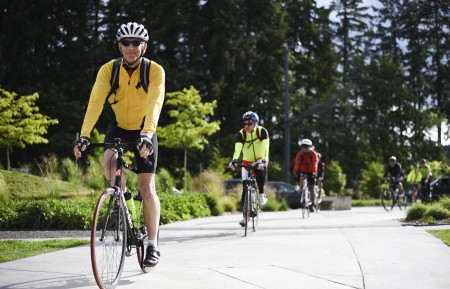How To: Start A Bike Commute

Want to try bike commuting? It's easy to get started and you'll be cruising on 2 wheels to work in no time.
Equipment to Get You Started
1. Helmet
In King County, helmets are required by law. Bicyclists throughout the county can be cited for not wearing helmets. Avoid fines and injuries by wearing a helmet!
When fitting a helmet:
- It should be level over your head
- Straps should converge under your earlobes.
- There should still be some room between the bottom strap and your chin so you can turn your head.
- There should also be about two fingers-length distance between your eyebrows and the helmet.
Once fitted, shake your head and see if the helmet moves-it should remain stationary.
2. Front and rear lights
Lights are very important to stay seen by other motorists and cyclists!
Washington State law (RCW 46.61.780) requires a front white light and a rear red reflector at least. Go Redmond often has safety lights available as give-a-ways at our tabling events, or you can request one.
Reflectors can be placed under the seat and in the spokes of the wheels to increase visibility. If you need to ride in a dark area, consider a more powerful light that will light up the trail but not blind others riders.
3. Bright or Reflective (& Comfortable!) Clothing
Wear something you can move in (spandex not required)!
Wearing light and bright clothing increases your visibility, and many sports outerwear will have reflective elements. If you need to pack your work clothes, rolling clothes into a backpack helps minimize wrinkles.
Or take a cue from our European friends and just get pedalling in whatever you were planning on wearing that day to work!
4. Locks
While not essential to get started, having the right lock is a good investment. U-locks, cable locks and chains are the most common locks. U-locks are better suited for locking your frame and potentially a wheel. Cable locks are better suited for securing the second wheel, or simply additional protection.
Planning Your Route
Check out the Redmond bike map for local bike facilities-like roads with bike lanes, or off road trails. Google Maps is also an incredibly useful and reliable tool to determine the safest and quickest route-their bike routes even include elevation changes!
Consider giving yourself extra time if you are trying out a route for the first time, as you may take false turns, hills may slow you down, or you might go slower to observe your surroundings.
Another great option is to ask the other people who bike in at work. They are a great source of local knowledge and insights into biking.
Rules of the Road
While riding in traffic, cyclists should take precautions to avoid any confusion or worse, collisions.
- Ride with traffic, not against it.
- Obey traffic laws. Bicyclists are not excused from lights, signs and speed limitations.
- If you are going the same or similar speed as traffic, you may ride down the middle of the road
- If you are going significantly slower than traffic, it is highly suggested to ride closer to the right side of the street so cars can pass you more easily.
- When approaching a red light, please do not maneuver between vehiclesand pass them to the front of the line. Turning vehicles may not see you quickly passing them by and turn without noticing you, causing a collision.
- When passing vehicles, pedestrians and other cyclists, please give 3 ft space.
- When preparing to take a left turn, feel free to take up an entire lane and maneuver to the left. Use your hand signal and let drivers around you know you are about to slow down and turn.
- Bicyclists are highly encouraged to used pre-existing bicycling infrastructure such as bike lanes and sharrows while riding in traffic.
- If you feel too unsafe riding on the road, you may ride on the sidewalk. On the sidewalk, ride with extreme caution. There are many driveways and pedestrians that create an unsafe environment for fast riding. Ride slow and have your hands on the brakes. Always yield to pedestrians, and enter a crosswalk very slowly or by walking your bike.
- If there is on-street parking, keep an eye out for opening doors! If possible, give yourself 3-5 ft distance from parked vehicles to avoid hitting a driver or a door.